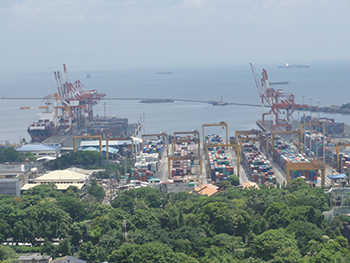Ocean cargo carriers must ramp up collaboration with terminals to ensure recovery
“It’s long past the time that carriers can continue losing money. Over capacity is just part of the problem. Maintaining better efficiencies at every stage of container transfer – including the waterside aspect – is key.”

Two new technological developments in Pacific Rim ocean cargo shipping took place last month that could redefine terminal and carrier strategies for the long term.
First came the announcement that Navis – part of Cargotec Corporation – is enhancing supply chain productivity at Davao International Container Terminal (DICT) in the Philippines by implementing its N4 terminal system, designed to increase throughput and productivity.
“As ports throughout Asia become increasingly congested and more expensive due to tariff increases, international shipping lines are looking to DICT as a key transshipment hub,” says Mark Welles, VP of Sales in Japan and Asia Pacific, Navis.
Within its second year of operation, adds Welles, DICT was already feeling the demand for increased capacity and as a result, constructed and finished its second container terminal berth last year.
“There is so much potential for growth in the region and we partnered with DICT to help them upgrade their operations to meet the demand from shipping lines, exporters and importers,” he says.
Located in the southeastern part of the Philippines, DICT offers container terminal facilities and services in this largely agricultural region. As more cargo now requires refrigerated containers, DICT transformed its operations to accommodate more than 80 percent of the terminal’s exports requiring refrigerated containers for fresh produce.
“As a relative newcomer to the container terminal business, we needed to make sure we had the best technology in place to help us compete with other, more seasoned operators,” says Bonifacio Licayan, Vice President, DICT.
In the same time frame, Navis was called upon to provide MACS3 loading computers ordered by China COSCO Shipping (CCS) Group for three 20,000 Twenty-foot Equivalent Units (TEUs) container vessels.
The onboard loading computer MACS3 covers a wide range of calculations relating to hydrostatics, intact and damage stability as well as the ship’s longitudinal strength.
Furthermore, a second contract covers six sister vessels with a capacity of 21,000 TEU to be built at Shanghai Wai Gao Qiao Shipyard and scheduled for delivery between May and December 2018. Finally, two additional 20,000 TEU container vessels are under construction at Dalian shipyard and will be equipped with the MACS3, with delivery scheduled for March and June 2018.
“These three series mark a new dimension for our onboard MACS3 loading computer,” said Dr. Selke Eichler, the Head of Customer Relation Management MACS3. “It has never been used to load cargo on vessels of this size.”

Sumitha Sampath, Senior Director of Product Strategy at Navis, tells LM in an interview that “carrier/terminal collaboration” is crucial to the ongoing recovery of ocean shipping.
“It’s long past the time that carriers can continue losing money,” she says. “Over capacity is just part of the problem. Maintaining better efficiencies at every stage of container transfer – including the waterside aspect – is key.”
She adds that addressing “transparency in the digitized age” will be a major part of the upcoming NavisWorld agenda.

Article Topics
Blogs News & Resources
Latest in Materials Handling
Registration open for Pack Expo International 2024 Walmart chooses Swisslog AS/RS and software for third milk processing facility NetLogistik partners with Vuzix subsidiary Moviynt to offer mobility solutions for warehouses Materials Handling Robotics: The new world of heterogeneous robotic integration BSLBATT is looking for new distributors and resellers worldwide Lucas Watson appointed CSO for Körber’s Parcel Logistics business in North America Hyster recognizes Dealers of Distinction for 2023 More Materials HandlingAbout the Author
Subscribe to Materials Handling Magazine

Find out what the world's most innovative companies are doing to improve productivity in their plants and distribution centers.
Start your FREE subscription today.
April 2024 Modern Materials Handling

Latest Resources










